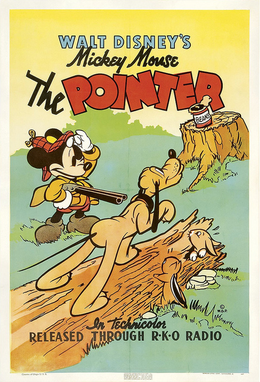The Pointer
The Pointer[edit | edit source]
The Pointer is a 1939 animated short film produced by Walt Disney Productions and released by RKO Radio Pictures. The film features Mickey Mouse and Pluto as they embark on a hunting trip. The Pointer is notable for its use of Technicolor and its nomination for an Academy Award for Best Animated Short Film.
Plot[edit | edit source]
The film begins with Mickey Mouse and his loyal dog Pluto setting out on a hunting expedition. Mickey is determined to teach Pluto how to be a "pointer" dog, a type of hunting dog trained to locate game birds. As they venture into the wilderness, Mickey explains the importance of being quiet and stealthy.
During their adventure, Mickey and Pluto encounter various wildlife, including a family of quail and a mischievous rabbit. The climax of the film occurs when Mickey and Pluto come face to face with a large bear. In a humorous and tense sequence, Mickey tries to reason with the bear, ultimately leading to a comedic chase.
Production[edit | edit source]
The Pointer was directed by Clyde Geronimi and featured the voice of Walt Disney as Mickey Mouse. The animation team included several notable Disney animators, such as Les Clark and Fred Moore. The film's background art was created by Claude Coats, contributing to the lush and detailed depiction of the forest setting.
The short film is recognized for its high-quality animation and the expressive character animation of Mickey and Pluto. The Pointer was one of the early Disney films to showcase Mickey Mouse with more realistic proportions and detailed facial expressions.
Reception[edit | edit source]
Upon its release, The Pointer was well-received by audiences and critics alike. It was praised for its animation quality and engaging storyline. The film was nominated for an Academy Award for Best Animated Short Film in 1939, highlighting its significance in the animation industry.
Legacy[edit | edit source]
The Pointer is considered a classic example of Disney's animation style during the late 1930s. It is often included in collections of Mickey Mouse shorts and has been featured in various Disney anthologies. The film's influence can be seen in later Disney productions, where character development and storytelling became central elements.
Related pages[edit | edit source]
Search WikiMD
Ad.Tired of being Overweight? Try W8MD's physician weight loss program.
Semaglutide (Ozempic / Wegovy and Tirzepatide (Mounjaro / Zepbound) available.
Advertise on WikiMD
|
WikiMD's Wellness Encyclopedia |
| Let Food Be Thy Medicine Medicine Thy Food - Hippocrates |
Translate this page: - East Asian
中文,
日本,
한국어,
South Asian
हिन्दी,
தமிழ்,
తెలుగు,
Urdu,
ಕನ್ನಡ,
Southeast Asian
Indonesian,
Vietnamese,
Thai,
မြန်မာဘာသာ,
বাংলা
European
español,
Deutsch,
français,
Greek,
português do Brasil,
polski,
română,
русский,
Nederlands,
norsk,
svenska,
suomi,
Italian
Middle Eastern & African
عربى,
Turkish,
Persian,
Hebrew,
Afrikaans,
isiZulu,
Kiswahili,
Other
Bulgarian,
Hungarian,
Czech,
Swedish,
മലയാളം,
मराठी,
ਪੰਜਾਬੀ,
ગુજરાતી,
Portuguese,
Ukrainian
Medical Disclaimer: WikiMD is not a substitute for professional medical advice. The information on WikiMD is provided as an information resource only, may be incorrect, outdated or misleading, and is not to be used or relied on for any diagnostic or treatment purposes. Please consult your health care provider before making any healthcare decisions or for guidance about a specific medical condition. WikiMD expressly disclaims responsibility, and shall have no liability, for any damages, loss, injury, or liability whatsoever suffered as a result of your reliance on the information contained in this site. By visiting this site you agree to the foregoing terms and conditions, which may from time to time be changed or supplemented by WikiMD. If you do not agree to the foregoing terms and conditions, you should not enter or use this site. See full disclaimer.
Credits:Most images are courtesy of Wikimedia commons, and templates, categories Wikipedia, licensed under CC BY SA or similar.
Contributors: Prab R. Tumpati, MD


